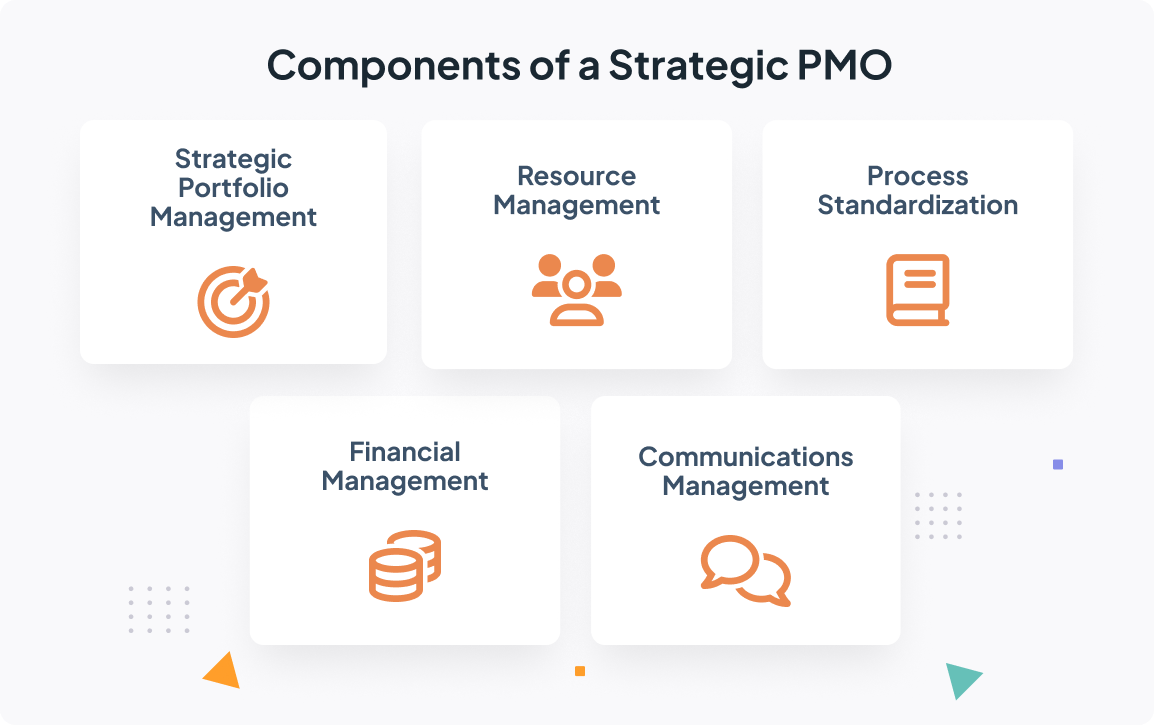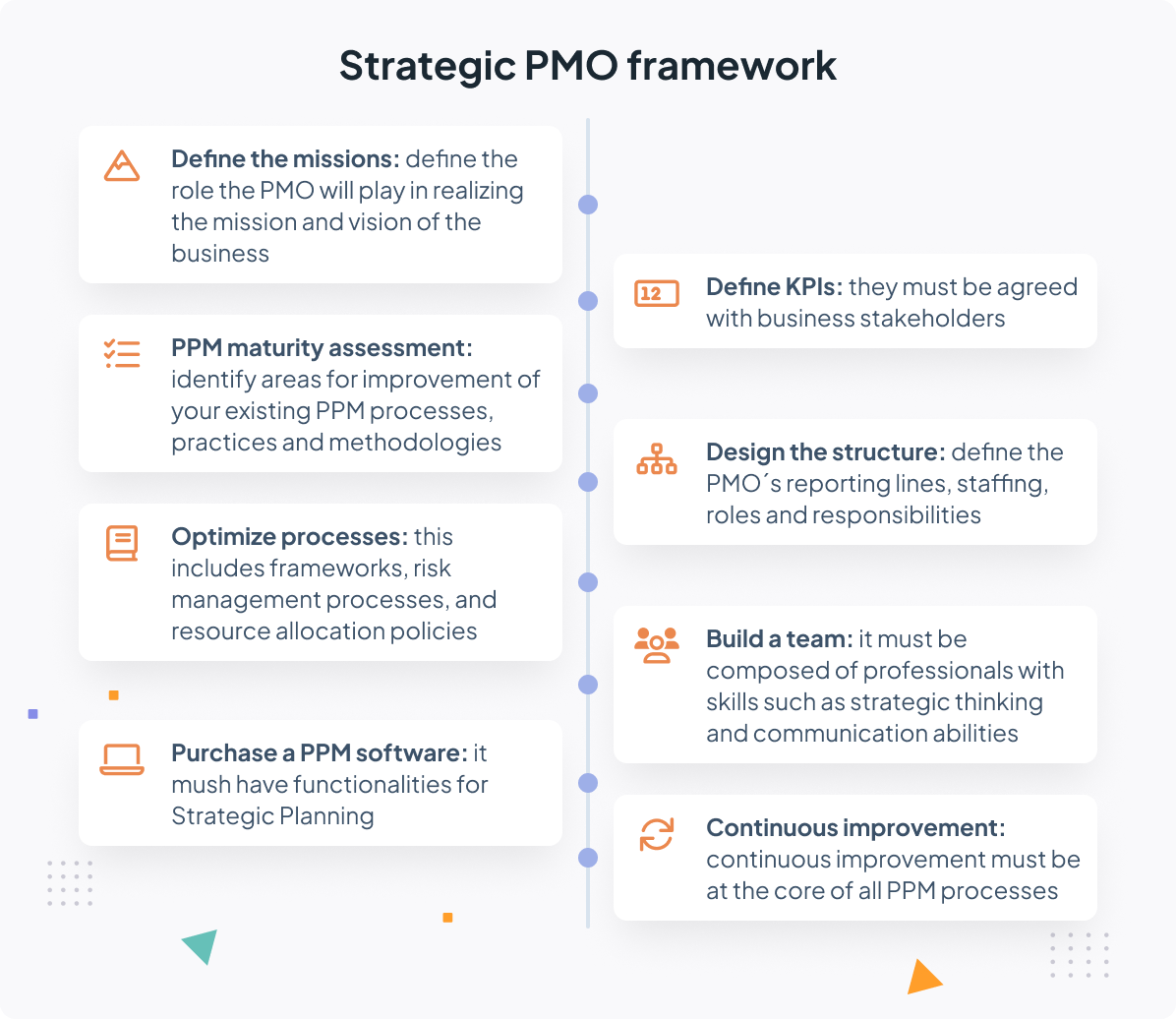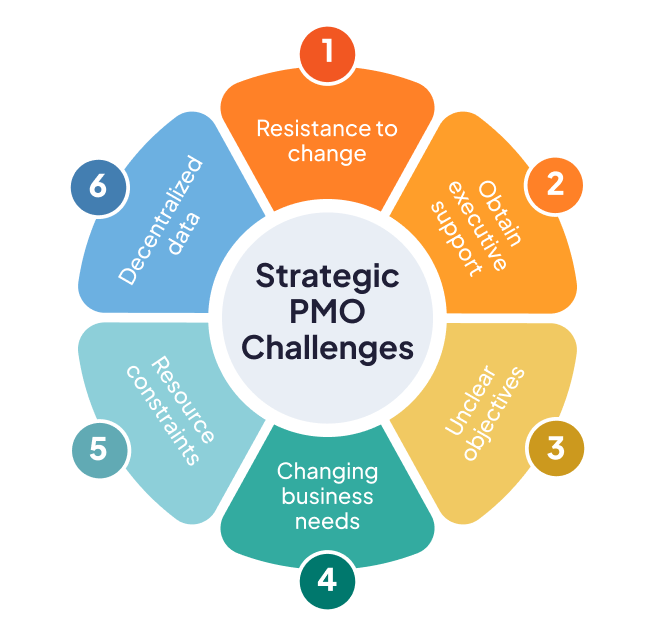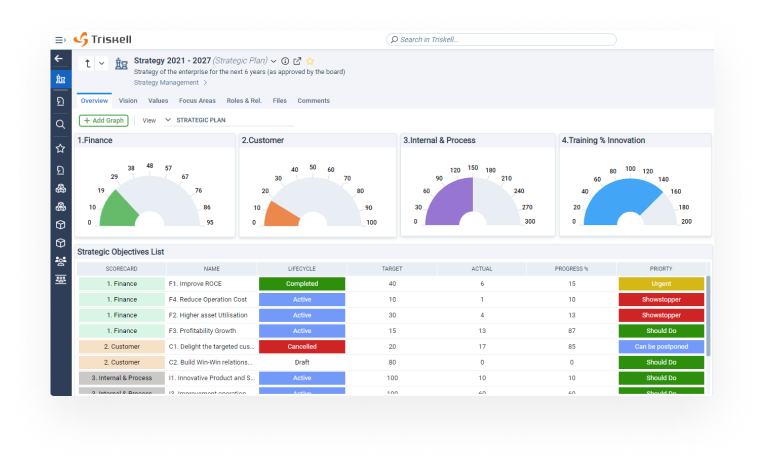The ultimate guide to create a Strategic PMO for impactful PPM

Can you imagine what it would be like to have a PMO in a company that goes beyond simple project management and is a key player in organizational success? Among the different types of Project Management Offices that exist, more and more companies are choosing to have a strategic PMO that will become the driving force of the organizations to achieve their strategic objectives.
In this post, we will show you the key roles and responsibilities of a strategic PMO, as well as the essential components for its success. You will discover how to create and consolidate it step by step, as well as the challenges and obstacles you will encounter along the way and how to overcome them to achieve a PPM focused on continuous value delivery.
What is a Strategic PMO?
Let’s start with the basics, what is a strategic PMO? Think of it as an enhanced version of a ‘standard’ PMO. It goes beyond project management and into the realm of strategic decision making.
As the head of a strategic PMO, your role will be to plan and manage projects and programs towards the long-term mission and vision of the organization, ensuring that every initiative counts. A fresh perspective on managing a PMO that, when executed well, can transform any company and make it thrive in an ever-changing business landscape.
A strategic PMO goes beyond Project Management and focuses on strategic decision making
See the Triskell platform in action in a personal demo
Key components of a Strategic PMO
Like any other business unit, such as Sales, Operations or Marketing, a strategic PMO must have a well-defined management structure and processes. Depending on the goals and objectives set by business executives, the components and processes of the PMO may change, but in general they should focus on the following areas:
- Strategic Portfolio Management: the PMO must work with the organization’s objectives always in mind. From idea generation to the selection, planning and management of key initiatives for the organization, and even the analysis and constant monitoring of the benefits obtained. All PMO operations must be designed with a single purpose in mind: to achieve the mission and vision established by the company.
- Resource Management: this includes a series of processes and competencies to ensure that each project, program or portfolio has the necessary resources and competencies at the right time. For example, capacity planning, inventory management, resource planning, resource allocation, etc.
- Standardization of processes throughout the company, especially those related to:
- Risk management of business portfolios.
- Demand Management.
- The establishment of quality standards for project and product execution.
- Financial management: a strategic PMO must not only ensure that the budgets allocated to each project or program are managed responsibly, but also that the funds and investments allocated to each initiative are in line with its expected value and the business objectives.
- Communications management: Stakeholder engagement is a key component for the success of a strategic PMO. To achieve this, you must have a communications plan managed from a single solution that also hosts all data related to portfolio management. This way, you will make executives, teams and all areas recognize the value that your PMO brings to the business.
Differences between a strategic PMO and a standard PMO
Now that you are clear about what a strategic PMO is and its main elements, let’s see what differentiates this type of Project Management Office from the more traditional ones.
PMO |
Strategic PMO |
|---|---|
|
It is operational, its main tasks are to monitor and deliver projects within the agreed deadlines and budgets. |
It is a key player in both strategy execution and strategy planning. |
|
It is static, and too rigid to pivot and adapt to changes. |
Adaptive approach according to changes in the company's strategy. |
|
Limited decision-making outside of project and program management. |
It influences all aspects necessary to achieve business objectives. |
|
Focus on project delivery. |
Focus on continuous value delivery for the business. |
A ‘traditional’ PMO has little scope of action beyond the mere supervision and delivery of projects. On the other hand, a strategic PMO is a key player in both the planning and execution of the strategy, with a special focus on continuous value delivery and adaptability to possible changes in objectives.
How to create a Strategic PMO: a 8-step framework
Now that you have seen in detail what a strategic PMO is, there is a detailed process to follow in order to implement it. From conception to implementation, we will show you how to define clear objectives, select key components and establish the solid foundation for a high-impact strategic PMO.
This is the step-by-step guide you should follow to implement a strategic PMO:
1. Identify the business objectives and vision
For a strategic PMO to be successful, you need to be clear about the organization’s mission and vision.
And from there, ask yourself: what role should the PMO play in making that mission and vision a reality? Only then will you be able to define a purpose and objectives for the PMO that are truly aligned with the organization’s overall strategy and serve as a guide for your decision making.
2. Assess the maturity status of your PPM
Next, you should assess your existing project management processes, practices and methodologies.
This analysis should help you draw conclusions about your strengths, weaknesses and areas for improvement, and will lay the foundations for the structure, responsibilities and scope of the PMO.
3. Define objectives and KPIs
Then, you should agree with executives and key stakeholders on the PMO’s objectives and performance metrics. This will help you focus on the projects and initiatives that will really bring value to the business.
4. Design the PMO structure.
In parallel to the previous point, depending on the objectives and maturity level of the PPM processes, you must design a structure for the PMO that fits the needs and idiosyncrasies of the organization. This includes reporting lines, staffing, roles and responsibilities.
The goal is to establish a structure that fosters collaboration, communication and seamless integration with existing business units.
5. Optimize the processes and methodologies you will be working with.
For the PMO to be successful, the processes and methodologies you will be working with need to be robust and standardized to ensure consistent project execution.
This includes management and governance procedures, frameworks for each project phase, risk management processes, and resource allocation guidelines agreed upon by key departments and stakeholders in the organization.
6. Build a multidisciplinary team
For a PMO to be successful, you must take care of the team you create. This team should be made up of professionals who combine knowledge and experience in project management with skills such as strategic thinking, leadership and communication skills.
You must also invest in their professional development and create a work environment that fosters collaboration and continuous learning.
7. Centralize all project portfolio management in a single PPM solution
To make your team’s work as efficient as possible, it is necessary to have the right suite of tools to help you in your decision making.
Therefore, having a PPM platform with strategic planning capabilities will allow you to connect all the projects and programs of the organization with the business objectives and the value that each initiative brings to the achievement of them.
8. Develop continuous improvement processes
Continuous improvement should be at the core of all strategic PMO processes. You should regularly review PMO performance in order to identify areas for improvement and refine your processes, methodologies and frameworks.
Do not hesitate to collect as much feedback as you can from stakeholders, project teams and PMO members themselves to make any necessary adjustments.
See the Triskell platform in action in a personal demo
Strategic PMO challenges and how to address them
As you complete the aforementioned stages for the creation and consolidation of the enterprise PMO, you will face different challenges for which you must be prepared. From resource optimization to strategic alignment with business objectives, you’ll see how to tackle every obstacle to elevate your PMO to new levels of efficiency and turn it into a true growth engine for your organization.
These are some of the challenges that every strategic PMO must face:
1. Resistance to change
Implementing a strategic PMO usually requires a cultural and mentality change, as there may be people and teams in the organization that may be resistant to this change for fear of seeing their work processes altered.
To address this challenge, effective change management is essential. Dialogue continuously with stakeholders, answer their questions and concerns, and make clear to them the benefits that the PMO can bring to the organization as a whole.
2. Gain executive support
Gaining immediate executive support is no easy task as executives may have competing priorities and may not be able to see the value that a strategic Project Management Office can bring.
To secure their support, provide reports that explain the potential ROI that can be achieved with the PMO, both in terms of cost savings and achievement of strategic objectives.
3. Unclear objectives and expectations
Not having clear objectives can lead to ambiguity and confusion. To prevent this from happening, you should explicitly define the purpose and scope of the PMO, and collaborate with PMO members and stakeholders to set realistic and measurable objectives. This will ensure that the entire organization is working toward the desired results.
4. Changing business needs
Today’s business landscape is constantly evolving, so strategic priorities can change in a very short time.
In order for the PMO to always be aligned with the organization’s vision, you must periodically review and reassess the PMO’s objectives and KPIs. You must be agile and responsive to changing business needs, as only then will you be able to adapt your approach and priorities accordingly.
5. Resource constraints
One of the biggest challenges faced by PMOs is related to a shortage of qualified personnel or budgetary constraints.
To overcome this challenge, you should prioritize initiatives based on their strategic value. And, if you are just setting up the PMO, we also recommend starting with manageable, high-impact projects to make the most of existing resources.
6. Decentralized data
PMOs need data to make informed decisions. Inadequate data collection, poor data quality or not having efficient tools for this purpose will make it more difficult to access and interpret data correctly. It is worth investing in Project Portfolio Management software to have the real-time data you need for informed and efficient decision making.
Best Practices for Sustaining a Strategic PMO
After you have created a solid strategic PMO and overcome the challenges listed above, it’s time to take it to the next level. In this section, we will explore the strategies and approaches that will enable you to optimize its performance, promote effective collaboration and ensure that it is aligned with business objectives.
- Put stakeholders at the center of your communication plan. Maintaining a strong relationship with stakeholders is crucial. We recommend that you regularly communicate the achievements, impact and value provided by the PMO to executives and other relevant stakeholders in the company’s decision making process. This will ensure, on the one hand, their support. And, on the other hand, they will eventually provide the PMO with more resources once the value it brings to the business is consolidated over time.
- Be agile when faced with changes in strategy. In today’s dynamic business environment, objectives and priorities can change rapidly due to multiple factors. And this is where your PMO must take an agile approach to strategy changes, reevaluating and realigning ongoing initiatives with business needs every 3 to 6 months. Continuous interaction with stakeholders here is key for the PMO to be aligned with the organization’s vision at all times.
Reevaluate and realign ongoing initiatives with business needs every 3 to 6 months
See the Triskell platform in action in a personal demo
- Make data-driven decisions. A PMO that does not base its decision making on data analysis is doomed to failure. Invest in PPM tools with advanced reporting and analysis capabilities to gain valuable insights into the performance of project portfolios, resource usage or incoming demand trends. With this data, you will be able to identify areas for improvement, optimize processes and improve your decision making when prioritizing initiatives.
- Foster innovation. Encourages within the PMO and project teams a spirit of innovation and creative thinking. Do not hesitate to explore new technologies, methodologies or test new practices to drive innovation and keep the PMO at the forefront of excellence in Project Portfolio Management.
- Continuous improvement of the process. Continuous improvement is vital in any strategic PMO. You should periodically review PMO processes and frameworks to identify bottlenecks and potential areas for improvement. Feedback from project teams is also critical to drive iterative improvements to your processes and make the Project Management Office increasingly efficient.
- Flexibility and scalability. As your organization grows and evolves, the PMO must adapt accordingly. When designing PMO processes and structures, you should ensure that both are flexible and scalable, so that the PMO can adapt to new types of projects or initiatives while maintaining consistent governance processes aligned with strategic objectives.
- Encourage collaboration and continuous learning. Break down silos and promote cross-functional collaboration and idea sharing across departments and project teams. In this way, you will enable the PMO to have access to a broader set of knowledge and perspectives.
Conclusion: Triskell Software, the PPM solution your enterprise PMO needs
And that’s all. We have tried to capture in this post all the information you need to create a strategic PMO with high business impact. Throughout this article we have shown you the fundamentals of a strategic PMO, its roles and responsibilities, and the key components for its success.
Now it’s your turn. Put into practice our step-by-step guide to create your own strategic PMO and face the challenges that may arise along the way. Remember that every obstacle is an opportunity to grow and improve.
And to complete this transformation, we invite you to get to know Triskell Software, the PPM solution with which you can manage project portfolios, optimize resources and make strategic decisions based on reliable data. Request a demo now and discover how it can boost the performance of your Project Management Office.
Request a demo of Triskell Software
Triskell meets all the requirements for your organization’s PMO to take a step forward in aligning your project portfolio with strategic planning.
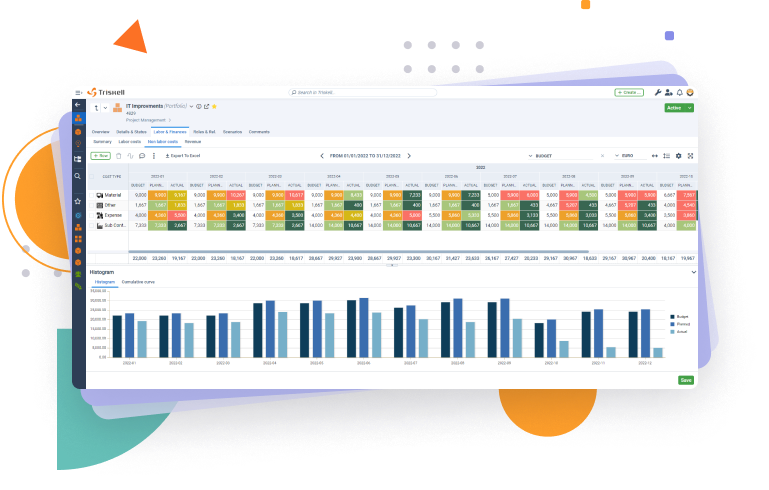
FAQs about Strategic PMO
How can PMOs establish a culture of continuous value delivery?
A Strategic PMO thrives on a culture of continuous value delivery. Here’s how PMOs can cultivate this environment:
- Align Projects with Strategic Goals: Ensure all projects directly contribute to the organization’s strategic objectives. Analyze potential projects to understand their strategic impact before adding them to the portfolio.
- Embrace Agile methodologies: Consider incorporating Agile practices that promote iterative development, rapid feedback loops, and continuous improvement. This allows for faster adaptation to changing market conditions and ensures value is delivered throughout the project lifecycle.
- Measure and track value: Establish clear metrics to measure the value delivered by projects. Track progress towards these metrics regularly and make adjustments as needed to ensure projects are on track to deliver strategic value.
How can PMOs effectively integrate Project Portfolio Management (PPM) with strategic goals?
Effective PPM is crucial for a Strategic PMO. Here’s how PMOs can integrate PPM with strategic goals:
- Strategic prioritization: Prioritize projects based on their alignment with the organization’s strategic goals. Analyze each project’s contribution to the strategic objectives before selection and resource allocation.
- Transparency and communication: Maintain clear communication channels between PMOs, project managers, and executives. Regularly report on project progress and how each project contributes to strategic objectives
- Portfolio Governance: Establish a governance framework to ensure alignment between project selection, execution, and strategic goals. This framework should define clear criteria for project selection, prioritization, and resource allocation, fostering a strategic approach to portfolio management.
How can PMOs establish clear communication channels with stakeholders?
Open communication is vital for a Strategic PMO’s success. Here’s how PMOs can build strong communication channels:
- Define Communication Channels: Establish clear communication channels with stakeholders at different levels (executives, project managers, team members). This may involve regular meetings, project reports, and a centralized communication platform.
- Tailor Communication: Adapt communication style and content to each stakeholder group. Executives may need high-level strategic updates, while project managers require detailed project progress information.
- Proactive Communication: Don’t wait for issues to arise before communicating. Regularly update stakeholders on project progress, potential roadblocks, and any changes in strategy or goals.
By building strong communication practices, Strategic PMOs can ensure everyone is aligned with strategic objectives and project progress, fostering a collaborative environment for successful value delivery.
Related Content

Why the CIO needs a PMO approach
Unlock business success: discover why the CIO must embrace a PMO approach! to elevate efficiency and boost productivity.

Lean Budgeting for Agile Portfolios: A Comprehensive Guide
Lean Budgeting: the financial revolution for Agile portfolios. Discover how to streamline project financing and optimize value delivery.

Implementing SAFe with a 7-step roadmap
Do you want to scale Agile at the enterprise level and don’t know where to start? We solve your doubts by explaining the steps to implement SAFe.
